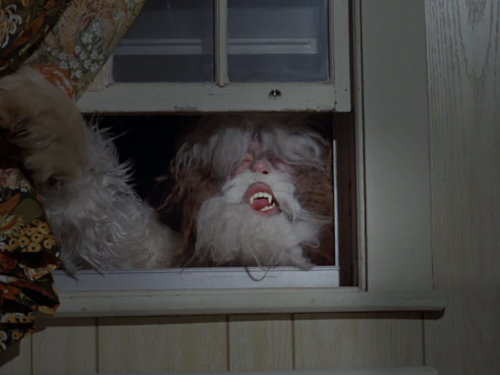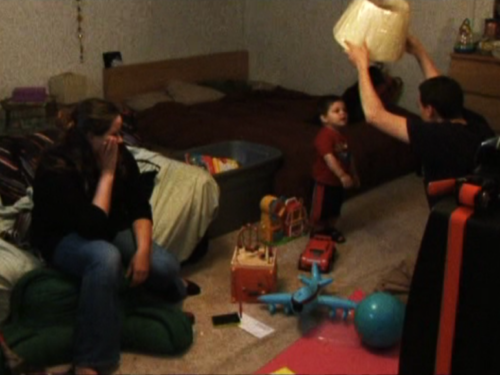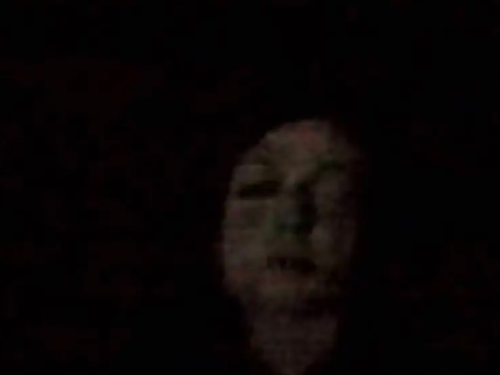Produced at The Ohio State University with a student crew, Dream’s Door follows a psychology student whose violent dreams begin to spill over into reality
A great deal of regional horror filmmaking gets pegged as surrealist, and the freeform approach taken to the material occasionally merits these comparisons. Jay Woelfel’s debut Beyond Dreams Door (1989), however, is the rare work in this mold that genuinely matches its aspirations with onscreen innovation. There are no accidental or unintentional moments of brilliance because everything is so measured and controlled, the planning and technical know-how several paces beyond the meager budget. That low-grade charm and bare bones necessity leads to impressively realized scenarios and effects that outpace mainstream contemporaries to this day. Both a nightmarish investigation into the lack of control we experience during our sleeping hours and a charming regional curiosity, Woelfel’s Beyond Dream’s Door is a film that exemplifies the independent horror market of the late-1980s just as that style was bowing out of prominence.
Psychology student Benjamin Dobbs (Nick Baldasare) has gone his entire life without recalling his dreams until he enrolls in a sleep study held by grad student Julie Oxel (Susan Pinsky). Department head Professor Noxx (Norm Singer) lectures Benjamin’s class on a case involving increasingly violent dreams that spilled into reality, something Ben recognizes all too well. After reading a record of Ben’s nightmares, Noxx determines that his student has been suppressing his dreams, these nighttime visions matching accounts published by the mysterious D.F. White (Daniel White) in his study on sleep. While Ben consults the texts late one night in the library, White appears and a hideous creature kills Noxx in the stacks, seemingly removing all traces of the professor from the Earth. Ben consults new psych TA Eric Baxter (Rick Kesler) with his latest nightmare of a massive warehouse-like space, which Eric recognizes as a location on campus and brings his subject in to visit. Though he explains the coincidence away as déjà vu, Eric himself becomes uneasy in the cavernous space. Ben has a bad sense that the large concrete doors in the room hide an unspeakable evil but is convinced to put his mission on pause.

Ben continues to dream of White, who gives him a missing page from his book that the dream forces are determined to capture. The nightmares soon begin to affect Eric and Julie, and the film posits dreams as a virus capable of infecting others via transmission and exposure. Ben and a reluctant Eric are forced to team up after Julie falls victim to the increasingly dangerous visions. Ben reveals that the dreams themselves move between worlds, and Julie and Noxx are not dead but have been captured by these forces until he himself as the dreamer can be killed. Only with the page of White’s book in Ben’s possession is there concrete proof of these events to stop the encroaching evil. Confronting the source of the nightmares in the ominous warehouse space, the film ends with an unrelentingly bleak turn. No one is saved and the only horror prevented is that of the future, the terrors of the past proving decisive.
Beyond Dream’s Door holds a special attraction for me as not just an Ohio-lensed independent horror effort, but one filmed in and around my hometown of Columbus. The film’s settings are places I know, ones that I can identify on sight and visit regularly each week.1 In many ways, my attraction to the film is due to its capture of a Columbus that no longer exists, one that I grew up in and knew well but hardly recognize now. The campus locales are a series of high-rise apartments and glass-faced structures rather than the two-story brick buildings I once frequented. The abandoned spaces that were once local legends and hangouts are long gone and distant memories for those who lived here.

Produced at The Ohio State University with a student crew, Beyond Dream’s Door is also an artifact of an era long past, when the university saw a spate of feature productions like William Lee’s Treasure of the Ninja (1982) and Eric Swelstad’s Heartland of Darkness (aka Fallen Angels/Blood Church, 1990/2022). Each of these titles have become genuine cult hits in the decades since their completion. Stories abound of film students entering and leaving university programs after finding the department and their peers unreceptive to genre filmmaking. This secondhand recollection makes it even more impressive that OSU’s department turned out so many cult and horror items, and such a shame that their production courses have been silent in the ensuing decades.
Woelfel graduated from Ohio State in 1985, having made a handful of short films including a 20-minute version of Beyond Dream’s Door. Between graduation and the feature’s production in 1988, he was busy planning his next moves and trying to get his first film off the ground. The majority of setbacks predictably involved funding. Cinematographer Scott Spears suggested expanding the short into a feature-length project and spoke with a professor in the film studies department. This allowed for the production to proceed as an independent studies course in advanced cinema production. Thus, the film was staffed with an all-student crew, and even served as part of producer Dyrk Ashton’s master’s thesis for OSU. The cast comprises local theater actors who had appeared in Woelfel’s earlier shorts, making this a family affair in many regards. Most importantly, the production served a film-starved creative community, passionate and talented performers, and craftsmen stranded in the heart of the Midwest. Ohio has never been a hotbed for major productions, despite a proud independent tradition best defined in the 1980s by Woelfel, Jim Van Bebber, and J.R. Bookwalter. The director himself recognized these limitations and moved to Los Angeles almost immediately after the film’s completion.
The film was born from a mix of outside influences and more personal elements. The chief inspiration was H.P. Lovecraft’s novella “The Shadow Out of Time,” which Woelfel believed to be unavailable for direct adaptation because of rights issues. The indefinable, abstract horrors of Lovecraft’s writings are ably realized onscreen thanks to the mysterious, clawed creature that appears throughout. There’s also the story’s reliance upon cursed texts and mysterious author D.F. White materializing to haunt Ben as much as he seems to help him. Woelfel also channeled his own collegiate loneliness into Ben’s predicament — his character left without family or friends and solitary in his nightmare scenario. The progression of the film’s narrative sees Ben evolve into a more capable and social being. He builds unlikely connections and trust with people immediately before losing them. The film’s conclusion provides a dark insight into this theme of communication and contact and posits a fatalistic worldview that sees outside forces intruding upon human connection. Loss is shown to be an inevitable consequence of interaction, whether as a result of self-sacrifice or circumstance. Another surprising source of ideas came from video poetry projects that the director encountered in his undergrad courses, hence the central poem providing the film’s title.

Beyond these personal and local inspirations, Woelfel’s debut feature succeeds as a genuinely inventive and impressive piece of regional horror filmmaking. Shot on 16mm and edited on video, the occasionally ruddy image quality actually abets the half-glimpsed nature of the film’s horrors. Woelfel manages to weave a surprisingly complex narrative that integrates Eric and Julie’s own experiences against Benjamin’s case. He brings their worlds together with a deft and natural touch. The film becomes increasingly fragmentary and nightmarish as it progresses, unclear where dreams and reality begin or end.
Related: Winterbeast (1992): Send in the Monsters! by Brett Wright
Sleep and dreaming are common fodder for the horror genre, and Beyond Dream’s Door arrived on the heels of more notable successes like the Nightmare on Elm Street franchise and 1988’s Bad Dreams. Rather than an imitative cash grab, Woelfel taps into the primal nature of nightmares and fear of sleep, tracing Ben’s troubles back to his childhood. Scenes of Ben recounting his dreams are intercut with inserts of graphic horror and unnerving imagery that is fluidly integrated thanks to the confident editing of Randy Spears and Susan Resatka (with assistance from Woelfel). The dream imagery also achieves a thematic unity thanks to recurring iconography, such as the unreachable red balloon that originated in Ben’s earliest childhood dream, a janitor with hooks for hands, and the paper airplane made of the missing book page. With all these elements, Woelfel subverts expectations and creates a work that manages to be genuinely surreal and disturbing rather than nonsensically nightmarish. Certain elements, like the consequences of dreams becoming physical threats, recall A Nightmare on Elm Street, but this is a film entirely unconcerned with slasher convention.
On an aesthetic level, the film is full of impressive FX work from creatures, to explicit gore, and jarring inserts. The use of ugly fluorescent lighting provides the many long academic building hallways with a sinister atmosphere in contrast with the warmer tones of apartment interiors. The reflective surface of embossed brick and over-polished linoleum floors provide surprisingly effective bits of location work. The scenes filmed in the library stacks are particularly evocative. They capture the unnerving quality of abandoned, shadowy corridors filled with dusty texts. Fluid, elaborate dolly shots and a constantly roving camera abound, and the high key colored lighting and heavy shadows, bizarre and uncanny camera angles all reveal greater artistic ambitions realized onscreen. One particularly impressive dream sequence leads from a brick factory through an abandoned house full of blank, wandering zombie-like figures. The location for the house was scouted off campus, not far from Sawmill Road, and demolished just days after filming, which shows the crew’s willingness (and even need) to trespass in order to complete the project, and also reveals a full embrace of the industrial ruin of a Columbus long gone.

Woelfel’s intentions were never to become a regional filmmaker; his aspirations were clearly much bigger. In between graduation and the film’s production, he won an award for young filmmakers that included a trip to the Cannes Film Festival, where he arrived with his screenplay and made connections for potential distribution upon completion. The film finally saw release on VHS thanks to VidAmerica, who may have gotten it into stores across the country and even abroad, but breached their contract. This led to a rare lawsuit that actually worked out in the filmmaker’s favor.
The locales for Beyond Dream’s Door were fortunate circumstances of Woelfel’s higher education. Regardless, on the strength of his first Ohio-lensed feature he belongs in all important discussions of the state’s genre filmmaking history. Ohio’s tradition of independent filmmaking is long, but it was only during the VHS era that the state was truly put on the map. Beyond Dream’s Door exemplifies the local affectations that make regional horror filmmaking such a captivating prospect, even for those unfamiliar with the locations captured on screen. Its location work does much the same for the comfortable, collegiate suburbs of Columbus as Jim Van Bebber’s Deadbeat at Dawn (1988) did for the urban wastelands of downtown Dayton, and J.R. Bookwalter’s The Dead Next Door (1989) for Akron. Even the video-lensed productions of 1990s obscurities like Mike Bennett’s Lord of the Shadows (Yellow Springs, 1990) and Sandusky’s Blade Independent Studios carry a distinctive midwestern charm and individuality. None of these filmmakers is alike, and Woelfel’s professional credentials deserve their own accolades elsewhere, but his first film bears the imprint of the place and people that formed his concerns and guided the course of his work to come.
In many ways, Beyond Dream’s Door does many of the things the later SOV filmmakers aspired to, but it’s part of an entirely different tradition. Its arrival in video stores came on the cusp of the final grasp for respectability and profit by independent producers cashing in on the video boom. Hundreds of like-minded releases have been forgotten or lost, relegated to bargain bin DVD collections or fodder for VHS collectors. Beyond Dream’s Door has persisted even as the very factors that enabled its creation have disappeared.
Stream Beyond Dream’s Door on Tubi and Amazon Prime
Beyond Dream’s Door is available on Blu-ray in Vinegar Syndrome‘s Home Grown Horrors Volume One boxset
(Split Tooth may earn a commission from purchases made through affiliate links on our site.)
Find the complete October Horror 2024 series here:

If you enjoyed this piece, please consider contributing to Split Tooth’s Ko-fi!
(We promise we aren’t buying coffee. All proceeds go to our writers and to maintaining the site.)
- Interiors for the professor’s home were filmed in the Upper Arlington suburb, exteriors in the North Campus neighborhood just a few miles from where I live now. And of course, extensive interior sequences were filmed in the university library where I work most days of the week. Finally, I went to high school with lead Nick Baldasare’s son. There’s also an obligatory, extended sequence filmed at local delinquent attraction The Gates of Hell, a sewage drain with a massive I-beam structure that’s a few minutes’ walk from my home and where I spent extended hours of my own high school off time. There are also portions of a nightmare filmed at what I believe to be the now-demolished Claycraft Brick Factory.




